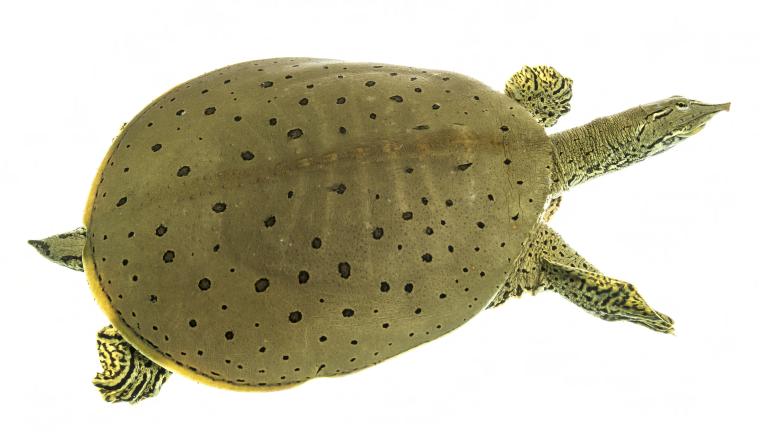Inclement Weather Office Closure:
The Colorado Parks and Wildlife Colorado Springs Office will be closed today, January 9, 2026, due to a snow event.
Inclement Weather Office Closure:
The Colorado Parks and Wildlife Colorado Springs Office will be closed today, January 9, 2026, due to a snow event.
The spiny softshell turtle buries itself in the mud at the bottom of ponds and lakes, using its long neck and powerful jaws to catch whatever prey swims by.

The spiny softshell turtle is one of the largest freshwater turtle species in the country. Unlike other turtles, their shell is soft, flat, and rubbery with small spines along the edges. The turtle lives most of its life in the water, so its feet are fully webbed to help it swim and it has a long, pig-like snout that it pokes above the water to breathe without exposing the rest of its body.
Shell flattened, with flexible edges and covered with leathery skin; small conical projections on front edge of upper shell; snout tubular, with a ridge along inner margin of each nostril; three claws on each front foot; vent near tip of tail; upper shell up to about 52 cm (20 inches) in females (but usually less than 30 cm or 12 inches), much smaller in males. Dorsal color pattern can change in response to surroundings and lighting.
Mature Male
Upper shell sandpapery, with small dark spots or circles; tail thick and long, with vent well beyond rear edge of upper shell; small conical bumps at front edge of upper shell.
Mature Female
Upper shell not notably sandpapery, often blotched or mottled; projections at front edge of upper shell conical or knoblike; tail relatively short.
Juvenile
Upper shell not sandpapery; tail short; coloration of upper shell as in adult male.
Hatchling
Upper shell olive to tan, with small dark circles, spots, or dashes, and a yellowish margin bordered by a black line; snout upturned; upper shell 30–40 mm (1.2-1.6 inches) long.
Eastern Colorado below about 5,500ft.
Streams ranging from large rivers to intermittently flowing creeks with permanent pools; also stream impoundments and ponds adjacent to permanent streams. Often basks on logs or banks.
Nests in open areas, usually close to water, mainly in June. Individual females may produce 1-2 clutches in a single year. Young hatch and emerge from the nest in late summer or early fall.